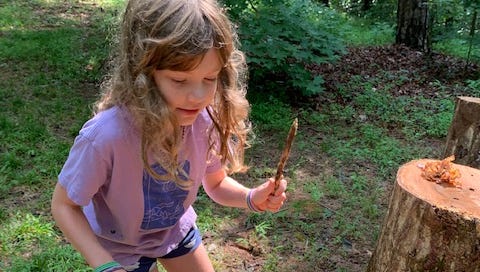(There’s a hint in the photo above! Can you guess?)
. . .
Belle: If you guessed beavers, you are dam right! Those “drum sticks” are actually beaver-chewed sticks we found along the Haw River. We chose beavers because they happen to be some of our favorite neighbors, even if they are a little standoffish.
Bea: They’re actually not standoffish, they’re just mostly nocturnal, which means they are more active at night. One early spring night last year, we went on a jog. It was still cold enough that it wasn’t too weedy, so we were running along the riverbanks. We stopped to talk to our neighbor, who said he’d seen evidence of beavers. We went along and while we were checking there was a dark shape.
Belle: It looked like a short, black dog!
Bea: But it was a beaver. It quickly slid down the banks into the river. Then it disappeared.
Belle: We haven’t seen it since, but we have seen signs of beavers. You can look for places where they’ve taken trees down, but another sign is a beaver-chewed stick. These sticks are commonly found along the river, where they get washed ashore. They usually have blunt, diagonal ends and have been stripped of their bark. You can see that toothmarks all around the stick, with small amounts of bark left behind. Some people sell these sticks on Etsy for kind of a surprising amount of money! Bea has a large beaver stick that she uses as a staff.
Bea: Beavers eat bark sandwiches! They actually don’t eat the outer bark, but the inside soft part of the bark, called the cambium layer. Beavers are sort of like kids who don’t like to eat the crust off of their sandwich (I am one of those kids)—they just want the soft part. They also eat buds, stems, and aquatic plants. They are herbivores.
Belle: What are some other cool facts about beavers?
Bea: They are the world’s second-largest rodent (after the capybara), which means they are mammals, like us. They can be from 24 to 70 pounds, which is big for a rodent, but they used to be enormous! Prehistoric beavers were the size of bears!
They are at home on land and under the water. They can swim under water for a long time—a half mile, or fifteen minutes, without popping their heads up at all.
Their dams are really cool, and important to the ecosystem. They make homes for other animals like tadpoles, turtles, and fish by creating calm, safe ponds.
Belle: Is that where beavers live?
Bea: Nope! They in live in their homes, called lodges. There are usually two secret underwater tunnels to their lodges, which they use as exits and entrances. Here’s a Wild Kratts video about beaver lodges.
And this David Attenborough video is even better, with footage taken inside a beaver lodge in winter!
Unlike a lot of mammals, beavers do not hibernate. They don’t need to because they have a warm, safe lodge and they also have food, which they ingeniously preserve by taking new saplings and branches and storing them under water. Beavers are most active in fall, when they are preparing for the winter.
Belle: I hope we see another beaver soon—maybe this fall. We recently saw what we think is a beaver lodge along the Haw, which we plan to investigate. But we would never take a stick or get too close—that’s their home!
Also, the National Parks Service has a beaver-dam-building activity that looks fun to try.
Bea: Have you ever seen a beaver in the wild? Or a sign that it was there? What are some of your favorite beaver facts?
Stay tuned for more about the ecological importance of beavers on Friday.






a confession i once stole wood from a beaver dam but we had moved to the farmhouse and i was just learning to build fires in our woodstove! riding my bicycle to the little country store i spotted a ditch packed with perfect little logs that fit in my huge paper
carrier basket! the farmer (our landlord) was always fussing abot the dam beavers and their dam beaver dams and threatening to blow them up with dynamite! i only took a few logs
i learned to build a fire ( and Grampa
cut plenty of wood to keep us warm!)
i never had to steal wood from a beaver again!(and i lived to tell the tale
I had a rare mammal sighting last week, Bea and Belle ... only the second one I’ve seen since 1974 ... a River Otter !